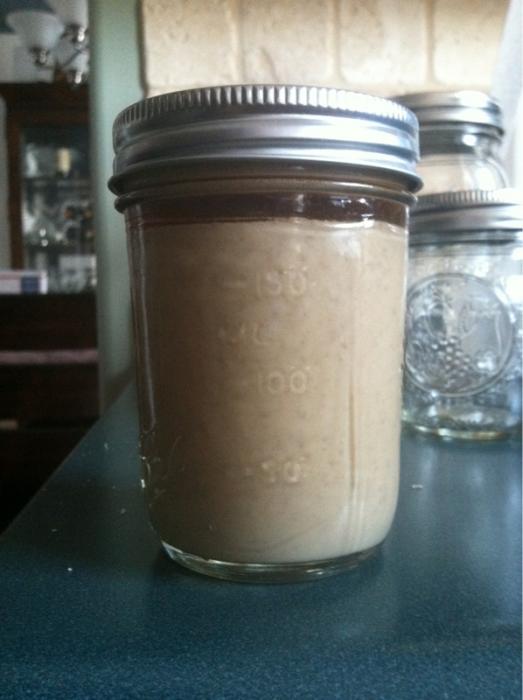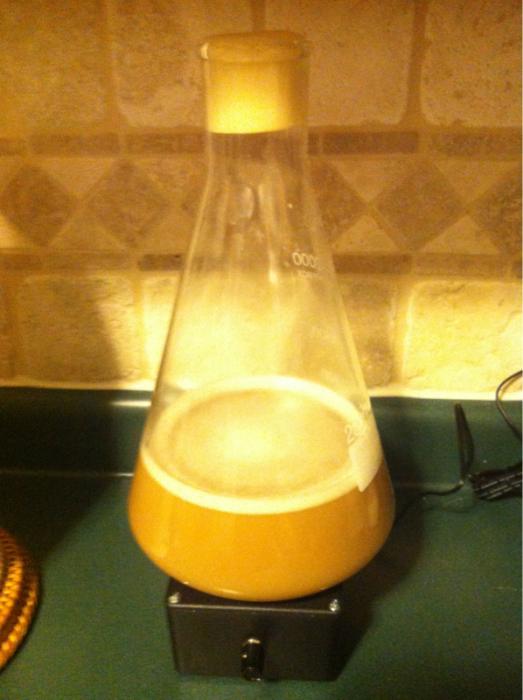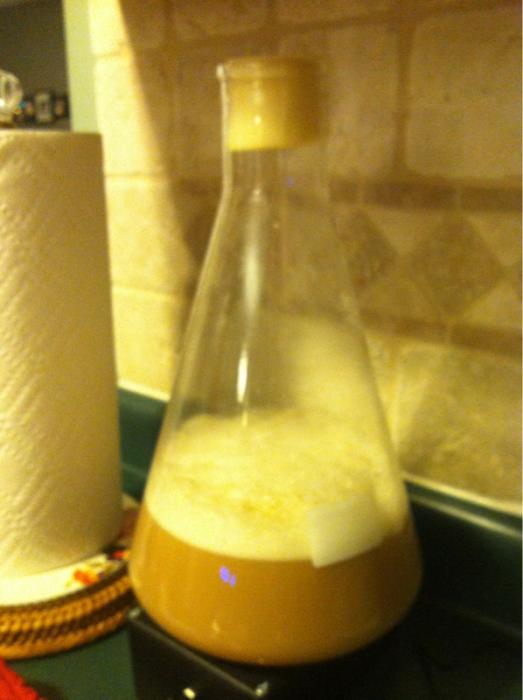I looked at the Mr. Malty calculator again and assumed that I had a fairly thin slurry with a fairly high non-yeast percentage and it said use around 200ml of slurry. So I dumped off that top layer of darker stuff, and poured 200ml of the lighter stuff into a container and that is what i'm going to use. I don't know why this situation makes me so nervous but here goes nothing.
You are using an out of date browser. It may not display this or other websites correctly.
You should upgrade or use an alternative browser.
You should upgrade or use an alternative browser.
Quick yeast washing question.
- Thread starter JoeSpartaNJ
- Start date

Help Support Homebrew Talk:
This site may earn a commission from merchant affiliate
links, including eBay, Amazon, and others.
Don't freak out too bad. Google for "yeast washing revisited" or something like that. It's a blog entry that claims there's just as much viable yeast in the "trub layer" as in the "yeast layer".... And even less bacteria in the trub. So even if you got your layers switched, you're still ok
Ok I swear this is my last question. I hope i'm not violating any HBT policies here by talking about this on two threads but if I am somebody please let me know. I'm just running out of time and wanted to expand the audience. I let the yeast settle out overnight and I think this is actually pretty think slurry now. So on mr malty if I assume 75% viability and 3.0/4.5 thickness and 25% non-yeast it tells me to pitch 100ml. That number is without a starter. So should I do a starter or not. Or should I just pitch the whole jar and let her rip.


Ok I swear this is my last question. I hope i'm not violating any HBT policies here by talking about this on two threads but if I am somebody please let me know. I'm just running out of time and wanted to expand the audience. I let the yeast settle out overnight and I think this is actually pretty think slurry now. So on mr malty if I assume 75% viability and 3.0/4.5 thickness and 25% non-yeast it tells me to pitch 100ml. That number is without a starter. So should I do a starter or not. Or should I just pitch the whole jar and let her rip.
100ml is plenty but if you are worried you can pitch 150ml. the whole thing is too much.
EarlyAmateurZymurgist
Well-Known Member
- Joined
- Aug 4, 2013
- Messages
- 518
- Reaction score
- 140
Brewers have been repitching yeast for centuries without the aid brewing calculators or Mr. Malty. Experience is the greatest teacher. Pitch the entire jar and take notes. If you do not keep a paper-based brewing log, you should start today. Brewing software is not a replacement for a proper brewing log. I have kept a paper-based brewing log since I started brewing back in the early nineties. It contains all of my observations, recipes, media formulations, and culturing activity. Heck, I even log things such as a change in how I wash and sanitize my kegs. Without a proper brewing log, troubleshooting any complex brew house problem is darn near impossible. Logging everything that happens in your brewery should be part of your brew house quality control program.
By the way, I have pitched up to 250mls of pure yeast slurry into a 5-gallon batch without the world ending.
By the way, I have pitched up to 250mls of pure yeast slurry into a 5-gallon batch without the world ending.

$10.99 ($31.16 / Ounce)
Hornindal Kveik Yeast for Homebrewing - Mead, Cider, Wine, Beer - 10g Packet - Saccharomyces Cerevisiae - Sold by Shadowhive.com
Shadowhive

$33.99 ($17.00 / Count)
$41.99 ($21.00 / Count)
2 Pack 1 Gallon Large Fermentation Jars with 3 Airlocks and 2 SCREW Lids(100% Airtight Heavy Duty Lid w Silicone) - Wide Mouth Glass Jars w Scale Mark - Pickle Jars for Sauerkraut, Sourdough Starter
Qianfenie Direct

$176.97
1pc Commercial Keg Manifold 2" Tri Clamp,Ball Lock Tapping Head,Pressure Gauge/Adjustable PRV for Kegging,Fermentation Control
hanhanbaihuoxiaoshoudian

$53.24
1pc Hose Barb/MFL 1.5" Tri Clamp to Ball Lock Post Liquid Gas Homebrew Kegging Fermentation Parts Brewer Hardware SUS304(Liquid MFL)
yunchengshiyanhuqucuichendianzishangwuyouxiangongsi

$22.00 ($623.23 / Ounce)
AMZLMPKNTW Ball Lock Sample Faucet 30cm Reinforced Silicone Hose Secondary Fermentation Homebrew Kegging joyful
无为中南商贸有限公司

$7.79 ($7.79 / Count)
Craft A Brew - LalBrew Voss™ - Kveik Ale Yeast - For Craft Lagers - Ingredients for Home Brewing - Beer Making Supplies - (1 Pack)
Craft a Brew

$20.94
$29.99
The Brew Your Own Big Book of Clone Recipes: Featuring 300 Homebrew Recipes from Your Favorite Breweries
Amazon.com
![Craft A Brew - Safale S-04 Dry Yeast - Fermentis - English Ale Dry Yeast - For English and American Ales and Hard Apple Ciders - Ingredients for Home Brewing - Beer Making Supplies - [1 Pack]](https://m.media-amazon.com/images/I/41fVGNh6JfL._SL500_.jpg)
$6.95 ($17.38 / Ounce)
$7.47 ($18.68 / Ounce)
Craft A Brew - Safale S-04 Dry Yeast - Fermentis - English Ale Dry Yeast - For English and American Ales and Hard Apple Ciders - Ingredients for Home Brewing - Beer Making Supplies - [1 Pack]
BellaRae

$58.16
HUIZHUGS Brewing Equipment Keg Ball Lock Faucet 30cm Reinforced Silicone Hose Secondary Fermentation Homebrew Kegging Brewing Equipment
xiangshuizhenzhanglingfengshop

$172.35
2 Inch Tri Clamp Keg Manifold With Ball Lock Posts, Pressure Gauge, PRV (0-30 PSI) – Homebrew, Fermentation, Kegging System
wuhanshijiayangzhiyimaoyiyouxiangongsi

$53.24
1pc Hose Barb/MFL 1.5" Tri Clamp to Ball Lock Post Liquid Gas Homebrew Kegging Fermentation Parts Brewer Hardware SUS304(Liquid Hose Barb)
Guangshui Weilu You Trading Co., Ltd
Thanks for all the info. I actually do keep a pretty good log but probably not as detailed as yours. Brewers friend gives me a place to store all my recipes and when I brew I create brew sessions where I type tons of notes. And I can keep notes about the beer up to and including when the keg is gone.
One way or another I'm going to use that slurry on Friday.
One way or another I'm going to use that slurry on Friday.
JoeSpartaNJ
Well-Known Member
Tomorrow is the big day. Going to brew my all centennial IPA and use one of the slurry jars I collected for the yeast option. I am going to use a jar with 200ml of slurry after dumping off the water layer on top.
Is this too much? Mr Malty suggests 177ml. I figure 200ml cant hurt.
I also bought some LD Carlson yeast energizer. it says add 1/2 tsp per gallon. When do I add it? 15 min left in boil? Post Boil?
Is this too much? Mr Malty suggests 177ml. I figure 200ml cant hurt.
I also bought some LD Carlson yeast energizer. it says add 1/2 tsp per gallon. When do I add it? 15 min left in boil? Post Boil?
Tomorrow is the big day. Going to brew my all centennial IPA and use one of the slurry jars I collected for the yeast option. I am going to use a jar with 200ml of slurry after dumping off the water layer on top.
Is this too much? Mr Malty suggests 177ml. I figure 200ml cant hurt.
I also bought some LD Carlson yeast energizer. it says add 1/2 tsp per gallon. When do I add it? 15 min left in boil? Post Boil?
200 ml is fine. there is probably enough dead yeast in the slurry to feed the yeast but if you want to add an energizer (marketing words more than anything else) 15 min before the boil is over is good.
JoeSpartaNJ
Well-Known Member
Poured off the clear liquid and pitched 200mls of straight slurry.
What kind of lag time should I be looking at? I pitched it around 4pm today, so almost 6 hours ago, and nothing as of yet. I was under the impression lag time would be shorter than pitching a new tube or dry yeast pack.
What kind of lag time should I be looking at? I pitched it around 4pm today, so almost 6 hours ago, and nothing as of yet. I was under the impression lag time would be shorter than pitching a new tube or dry yeast pack.
stpug
Well-Known Member
- Joined
- Nov 5, 2012
- Messages
- 3,808
- Reaction score
- 769
Poured off the clear liquid and pitched 200mls of straight slurry.
What kind of lag time should I be looking at? I pitched it around 4pm today, so almost 6 hours ago, and nothing as of yet. I was under the impression lag time would be shorter than pitching a new tube or dry yeast pack.
It generally is shorter, but it still lags
JoeSpartaNJ
Well-Known Member
Checked again this morning....still nothing. I am going to chalk it up to tired yeast and not collecting quick enough.
I will go to my LHBS and pick up some fresh yeast this morning and re-pitch.
As for the samples I still have in the fridge, I will hold onto them and experiment. I will try to make a starter with one to determine if the yeast is truly dead or not.
I will go to my LHBS and pick up some fresh yeast this morning and re-pitch.
As for the samples I still have in the fridge, I will hold onto them and experiment. I will try to make a starter with one to determine if the yeast is truly dead or not.
Checked again this morning....still nothing. I am going to chalk it up to tired yeast and not collecting quick enough.
I will go to my LHBS and pick up some fresh yeast this morning and re-pitch.
As for the samples I still have in the fridge, I will hold onto them and experiment. I will try to make a starter with one to determine if the yeast is truly dead or not.
Good idea but wait until tomorrow morning to repitch. Sometimes yeast take off like a rocket, sometime more like a snail. No point in repitching if the yeast were just sleeping off a hangover.

JoeSpartaNJ
Well-Known Member
RM-MN said:Good idea but wait until tomorrow morning to repitch. Sometimes yeast take off like a rocket, sometime more like a snail. No point in repitching if the yeast were just sleeping off a hangover.
Should I re-aerate the wort if it does not take off overnight?
Should I re-aerate the wort if it does not take off overnight?
no. once you pitch the yeast you don't have to even look at it for 2 weeks or more.
JoeSpartaNJ
Well-Known Member
eastoak said:no. once you pitch the yeast you don't have to even look at it for 2 weeks or more.
I meant do I need to re-aerate the wort because I will be pitching new yeast. Wort has been idle in fermenter for a day and a half with no activity. No bubbling or krausen formation.
I meant do I need to re-aerate the wort because I will be pitching new yeast. Wort has been idle in fermenter for a day and a half with no activity. No bubbling or krausen formation.
oh, yes, you aerate the wort before pitching the yeast. when i see re-aerate i think you aerated then were wondering about aerating again after pitching the yeast, i wouldn't do that in this case.
JoeSpartaNJ
Well-Known Member
Pitched a new vial of WP 001 last night around 11pm.
Lets see what happens.
Lets see what happens.
Pitched a new vial of WP 001 last night around 11pm.
Lets see what happens.
how much time did you give the original pitch?
JoeSpartaNJ
Well-Known Member
eastoak said:how much time did you give the original pitch?
36 hours
36 hours
not enough time. after you pitched you should have left it alone. do you have a way to control the fermentation temperature?
JoeSpartaNJ
Well-Known Member
eastoak said:not enough time. after you pitched you should have left it alone. do you have a way to control the fermentation temperature?
Rich now it is in my basement where the ambient temperature is 63 degrees. It is sitting in a Rubbermaid container in water.
eastoak said:not enough time. after you pitched you should have left it alone. do you have a way to control the fermentation temperature?
I gotta disagree with this one. If you aren't bubbling at all within 36 hours something is definitely wrong. Maybe not the yeast being "dead" but something was wrong.
I gotta disagree with this one. If you aren't bubbling at all within 36 hours something is definitely wrong. Maybe not the yeast being "dead" but something was wrong.
something was wrong, the brewer was in a hurry. if the first yeast he pitched was WLP 001 then 63 degrees is too cool for that yeast, it would still get the job done but at a slower rate. it's important to control the temperature of the fermentation within the temperature range of the yeast not just some random cool temperature. according to white labs the optimum temp for WLP 001 is 68 to 73 degrees.
JoeSpartaNJ
Well-Known Member
eastoak said:something was wrong, the brewer was in a hurry. if the first yeast he pitched was WLP 001 then 63 degrees is too cool for that yeast, it would still get the job done but at a slower rate. it's important to control the temperature of the fermentation within the temperature range of the yeast not just some random cool temperature. according to white labs the optimum temp for WLP 001 is 68 to 73 degrees.
I agree as the brewer. This was the first time re-pitching yeast and only the 3rd time in 40 plus batches using a liquid yeast.
On the original batch of this yeast, it was a warmer climate and original fermentation temperature was around 68 degrees. I saved the yeast a week after racking original beer due to certain life events, although I did leave a layer of wort on top of it. It was 14 days after saving the yeast cake that it was pitched. Per the results I got from mr malty, the 200ml of slurry I pitched should have been adequate.
Things I should have probably considered... My basement used to be much warmer in the winter months. After my boiler died last year and replaced with a much more efficient model, my ambient temps down there are between 63 and 65 in the winter. Previously between 72 and 75.
Also like I mentioned before, I am not a usual liquid yeast user. My usual go to's are Us-05 and Nottingham. Those yeast work in pretty much any condition and are not very tempermental. After this, probably will switch back to them for their convenience. I also do not rehydrate dry yeast or make starters for liquid yeast (my bad.)
Will that being said, I have moved the fermentor upstairs and placed it next to my kegerator where it is warmer. Ambient temperature in my house in the cold months is between 67 and 70 degrees.
Thanks to everyone for their help.
I did buy some DME yesterday as I plan to try to make a starter with yeast that is still in my refrigerator and see if it is still viable. If it is not, I will pitch dry yeast in my next batch.
Thanks again,
Joe
eastoak said:if the first yeast he pitched was WLP 001 then 63 degrees is too cool for that yeast, it would still get the job done but at a slower rate.
We are totally on the same page here. I thought you were trying to say his lag time was normal. I didn't mean anything by my comment and i fully agree with what you are both saying and that the temp was probably the issue.
When i first started brewing i fermented in a basement with a concrete floor. I thought i was golden because the room temp was always around 70 degrees. My first few beers took days and days to get going and never really took off. Then i stuck a thermometer strip on the fermenter and the temp was 60 because the concrete floor was super cold. Started putting the fermenters on a table or a towel and never had a problem again.
On another note related to pitching the slurry, i pitched mine yesterday and the beer was bubbling within hours and chugging right along today. My slurry settled out around 175ml before i used it and it looked really clean. What i love is the beer is not going completely insane right now. Its actually fermenting exactly like the last beer i did which means i think the mr malty calculator was pretty close. I am now officially over my fear and will be re-using yeast many times now in the future. I think i could pitch half of what i did and i would probably still be fine but i guess that number changes a lot with the age of the yeast.
Cheers
JoeSpartaNJ
Well-Known Member
And to update, fermenter started churning a hour after moving to warmer temp area.
I did a starter tonight with 100ml of slurry i pulled from a pale ale made with California ale yeast. When i say slurry i mean 100 ml of yeast that settled out over the last two weeks after being washed. Here are the results. I don't understand why i didn't start reusing yeast sooner because its easy and saves a ton of money. This thing is going ballistic after only like 5 hours. 

Attachments
Similar threads
- Replies
- 1
- Views
- 311
- Replies
- 3
- Views
- 866
- Replies
- 36
- Views
- 2K

















































